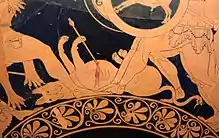Orthrus
Orthrus (Grekçe: Ὄρθρος, Orthros) veya Orthus (Grekçe: Ὄρθος, Orthos), Yunan mitolojisinde, mitograf Apollodorus'a göre, Geryoneus'un sığırlarını koruyan ve Herakles tarafından öldürülen çift başlı bir köpekti.[1] Ehidna ve Tifon canavarlarının ve aynı zamanda çok başlı bir bekçi köpeği olan Kerberos'un erkek kardeşiydi.[2]
İsmi
Adı "Orthrus" (Ὄρθρος) veya "Orthus" (Ὄρθος) olarak tasvir edilir. Örneğin, en eski kaynak olan Hesiod bu tazıya "Orthus", Apollodorus ise "Orthrus" adını verir.[3]
Mitoloji
Hesiodos'a göre Orthrus, Sfenks'in ve Nemea aslanının babasıydı, ancak Hesiodos'un anne olarak kastettiği kişinin Orthrus'un annesi Echidna, Kimera veya Keto olup olmadığı belirsizdir.[4]
Ayrıca bakınız
Kaynakça
Dipnotlar
- Apollodorus, 2.5.10.
- Hesiod, Theogony 306–312; Apollodorus, 2.5.10. Quintus Smyrnaeus, Posthomerica (or Fall of Troy) 6.249 ff. (pp. 272–273) has Cerberus as the offspring of Echidna and Typhon, and Orthrus as his brother.
- Hesiod Theogony 293, 309, 327; Apollodorus, 2.5.10. For the form of the name used in other sources see West, pp. 248–249 line 293 Ὄρθον; Frazer's note 4 to Apollodorus, 2.5.10.
- Hesiod, Theogony 326–329. The referent of "she" in line 326 of the Theogony is uncertain, see Clay, p.159, with n. 34.
Genel
- Apollodorus, Apollodorus, The Library, with an English Translation by Sir James George Frazer, F.B.A., F.R.S. in 2 Volumes. Cambridge, Massachusetts, Harvard University Press; London, William Heinemann Ltd. 1921. Online version at the Perseus Digital Library12 Aralık 2016 tarihinde Wayback Machine sitesinde arşivlendi..
- Bury, J. B. The Isthmian Odes of Pindar, Macmillan, 1892.
- Cook, Arthur Bernard, Zeus: A Study in Ancient Religion, Volume III: Zeus God of the Dark Sky (Earthquakes, Clouds, Wind, Dew, Rain, Meteorites), Part I: Text and Notes, Cambridge University Press 1940. Internet Archive
- Clay, Jenny Strauss, Hesiod's Cosmos, Cambridge University Press, 2003. 978-0-521-82392-0.
- Fennel, Charles Augustus Maude, Pindar: The Nemean and Isthmian Odes : with Notes Explanatory and Critical, Intro., and Introductory Essays, University Press, 1883.
- Gantz, Timothy, Early Greek Myth: A Guide to Literary and Artistic Sources, Johns Hopkins University Press, 1996, Two volumes: 978-0-8018-5360-9 (Vol. 1), 978-0-8018-5362-3 (Vol. 2).
- Hesiod, Theogony, in The Homeric Hymns and Homerica with an English Translation by Hugh G. Evelyn-White, Cambridge, Massachusetts., Harvard University Press; London, William Heinemann Ltd. 1914. Online version at the Perseus Digital Library23 Ağustos 2015 tarihinde Wayback Machine sitesinde arşivlendi..
- Mertens, Joan R., How to Read Vases, Metropolitan Museum of Art, 2010, 9781588394040.
- Ogden, Daniel, Drakon: Dragon Myth and Serpent Cult in the Greek and Roman Worlds, Oxford University Press, 2013. 9780199557325.
- Pindar, Odes, Diane Arnson Svarlien. 1990. Online version at the Perseus Digital Library.
- Race, William H., Nemean Odes. Isthmian Odes. Fragments, Edited and translated by William H. Race. Loeb Classical Library 485. Cambridge, Massachusetts: Harvard University Press, 1997, revised 2012. 978-0-674-99534-5. Online version at Harvard University Press.
- Schefold, Karl, Luca Giuliani, Gods and Heroes in Late Archaic Greek Art, Cambridge University Press, 1992. 9780521327183
Dış bağlantılar
| Wikimedia Commons'ta Orthrus ile ilgili ortam dosyaları bulunmaktadır. |
This article is issued from Wikipedia. The text is licensed under Creative Commons - Attribution - Sharealike. Additional terms may apply for the media files.

